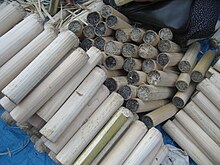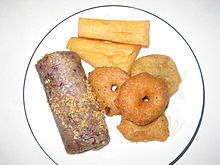Sticky rice in bamboo
 Burmese sticky rice in bamboo | |
| Region or state | Southeast Asia |
|---|---|
| Associated cuisine | Burmese, Cambodian, Lao, Thai, Vietnamese |
| Main ingredients | Glutinous rice, hollow bamboo tubes |
| Similar dishes | Lemang, Daetong-bap, Chunga Pitha |
Sticky rice in bamboo is a common
Names
The dish is known by various names throughout Southeast Asia, including paung din (ပေါင်းတင်း) or kauk hnyin kyi dauk (ကောက်ညှင်းကျည်တောက်) in Burmese, kralan (ក្រឡាន) in Khmer, and khao lam (ข้าวหลาม, pronounced [kʰâw lǎːm]; ເຂົ້າຫລາມ) in Lao and Thai and cơm lam in Vietnamese. In Lao and Thai, khao means rice and lam means the cooking process, which involves roasting the contents in prepared bamboo sections, while in Vietnamese cơm lam translates as "bamboo cooked rice".
In Malaysia and Indonesia, it known as
Variations
Cambodia

In
During harvest season, Cambodian Buddhists in the Angkor region celebrate a particular nocturn rite during which local peasants lay down next to each other in what is called a plang kralan (ប្លុងក្រឡាន) as sticky rice bamboo being grilled to form a human bridge on which the Buddhist monks walk in order to obtain merits and hope of an abundant harvest.[4]
Laos

Sticky rice is ingrained in the national culinary heritage and figures in religious traditions of the Lao people.
Myanmar (Burma)

Paung din (ပေါင်းတင်း) or kaukhnyin kyidauk (ကောက်ညှင်းကျည်တောက်) is another ready-to-eat portable form cooked in a segment of bamboo. When the bamboo is peeled off, a thin skin remains around the rice, and it also gives off a distinctive aroma.
Thailand
Khao lam uses
In the past, Thailand had innumerable bamboo trees. Thai people thought about the utility of using bamboo for cooking purposes. The ingredients of khao lam are glutinous rice, black beans, coconut milk, sugar and salt.[9] Moreover, taro or young coconut may be added.
-
Khao lam with coconut custard
-
An opened khao lam with purple sticky rice
Vietnam
In Vietnam, it is called cơm lam and found in the Northwest Mountainous Area. It originated when
-
Cơm lam from the Central Highlands
-
Cơm lam before grilling
See also
References
- ^ a b Taing, Rinit (21 February 2018). "Hard work put into roadside snack favourite kralan". The Phnom Penh Post. Retrieved 25 October 2019.
- ^ Nhem, Chea Bunly (22 May 2004). "Let Them Eat Cake". The Cambodia Daily. Retrieved 11 January 2009.
- ^ "Kralan on Kilometer 28". Khmer Times. 2 June 2016. Retrieved 16 November 2016.
- ^ Khieu, Chan. "៥៥. ប្លុងក្រឡាន" [Plang Kralan]. Yosothor. Retrieved 2022-07-16.
- ^ "A Taste of Sticky Rice, Laos' National Dish". Smithsonian Magazine. Retrieved 2021-07-17.
- ^ The Foreign Missionary. Mission House. 1876. pp. 121–122.
- ^ "Khuen Khao Phao Khaolam Tradition: Rituals, Ceremonies and Local Festivals in Thailand Database". 27 April 2017.
- ^ ""ข้าวหลามปลาร้า" แซบสไตล์อีสาน สูตรเด็ดแม่แอ๊ด โอทอปนครปฐม". ASTV ผู้จัดการออนไลน์. Archived from the original on 2015-05-18. Retrieved 2015-05-17.
- ^ "ข้าวหลาม อาหารจากภูมิปัญญาไทย". Sukhothai Thammathirat Open University. Archived from the original on 2015-09-24. Retrieved 2015-05-17.
- ^ Anthropos Volume 99, Issue 1 Österreichische Leo-Gesellschaft, Görres-Gesellschaft, Anthropos Institute - 2004 "3.1 Cơm lam The Vietnamese still see the Tháy as people who eat cơm lam, muôi ông (in-bamboo-tube cooked [glutinous] rice and [who store] salt in bamboo tube). They believe, when one is in forest regions, one has to eat this type of com ..."
- Vietweek, Thanh Nien News, Vietnam Youth Association Delicacy made in a bamboo stem - Visit the Central Highlands to discover spectacular sceneries and eat and drink like a mountain dweller Archived 2012-06-19 at the Wayback MachineJune 8, 2012 print issue, June 16, 2012 web edition. "Anyone visiting the Central Highlands should try cơm lam (rice cooked in bamboo stems) and grilled chicken. It is a fascinating experience to eat the rice and chicken by dipping it in sesame and salt and drink rượu cần (a beer-like drink sipped through a long bamboo pipe from a jar) like the mountain people do. Cơm lam has its origins in the mountainous lifestyle when tribesmen made long journeys through the forest to work on mountain fields."
External links
- Pictures of kralan being made
- ក្រឡាន Kralan. Chef Nak. 7 July 2022.




